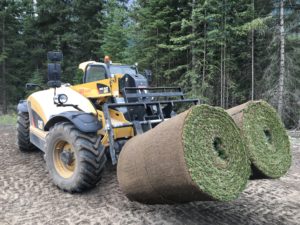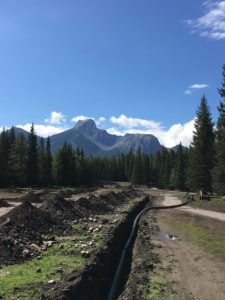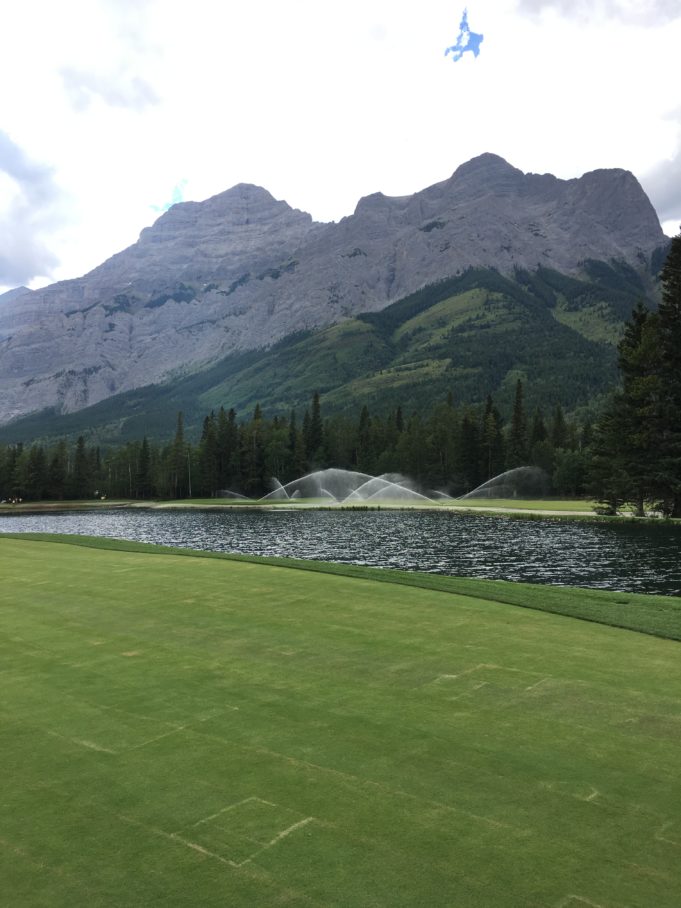Darren Robinson had one of the most envied views in Alberta from an office.
The General Manager of Kananaskis Golf Club could lookout and see what Robert Trent Jones Sr. crafted in one of the most picturesque regions of Alberta.
Then the massive flood of 2013 wiped that view away with such a force it was hard to fathom.
On the morning I called Darren to do this interview he was dealing with a real world problem-his smart phone wasn’t being so smart but at least he had that view again-sort of.

“I can stand up and look out the window and I can see all the sod being unloaded and all the finishing work taking place on the 18th hole of Mount Lorette and green grass on ten, a dozer off between 18 and nine. There’s lots of activity going on here from this vantage point.”
It’s been almost five years since the raging waters ripped through the valley and put an end to 23 straight years of golf being played on Mount Lorrette or Mount Kidd.
Robinson recalls the day vividly as he got married to his fiancé June 15th and the plan was for a mini-honeymoon to California June 20th.
“I got a knock on my door about 5:30 that morning and it’s our superintendent and he says, we’ve got a problem.” A truck ride over to the 16th hole on Mt. Kidd and the problem was very evident. Water was gushing across the fairway, over the power line, on to the driving range and beyond.
As the day progressed, the water kept rising and the flow became more violent.
“It went from flowing over the surface to carving new channels and just eroding everything in it’s path,” he said. “It got down to even taking out our municipal water system which is eight feet below the ground.”

Robinson said it was difficult to not get wrapped up in what was happening to the world 150 people at Kananaskis knew intimately. The focus was on the two golf courses and what could be done. In the meantime, the provincial government was dealing with the southern part of the province which was hammered as well.
“For them (government) it was like triage at the hospital. They had to pick the things that they felt were the top priority items and start tackling things bit by bit,” he said. “We just weren’t at the top of that priority list so therefore there was a bit of time which took place before any decisions were made on the golf courses.”
Fast forward to August of 2014 and work began on the monumental task of bringing back to life two iconic golf courses. Within a couple of weeks of getting the green light crews and equipment were mobilized to clean up thousands of trees, rocks, layer upon layer of silt and backfilling deep channels which were carved through both golf courses. It was both therapeutic and emotionally draining.

Robinson said he put out a call to his friend and golf course architect Gary Browning ,asking him to come over to give him is thoughts on what may lie ahead of the crew at Kananaskis.
He was there the next day at 9.a.m. and brought with him his practical approach to this massive problem, said Robinson.
“He said, Darren, it’s a mess and there’s a lot of damage but we can do this. No problem.”
One of the steps they took on the road to recovery was to make sure they had as little impact environmentally on the course. Robinson says instead of stripping all the turf off the course and hauling it away they used a piece of equipment which pulverized the turf and left behind what he called “a beautiful organic medium to work with.”
It still looked like absolute devastation to the untrained eye but Robinson said for them it was a blank canvas on which they could work with. They are still using the majority of the original brush strokes of Robert Trent Jones Sr. but adding their own artistic ideas based on golf knowledge and maintenance considerations.
Jump ahead to 2017 and all 36 holes are rough-shaped with 16 holes on Mount Lorrette grassed, all 36 greens have been constructed and now it’s a matter of putting the finishing touches on the masterpiece.
Robinson says this work has been similar to a home renovation in such a way as you have things you liked about your home and things which didn’t work but with everything demolished you can now tweak those things you feel need tweaking.
“From a customer’s standpoint, my sense is that people are going to come here and they’re going to know that it looks and feels and plays as good or better than it ever did before but they may not be able to pinpoint all the reasons why because they’re subtle.”

So essentially what is in place now is what was there before the flood. What is also in place is a feeling of security for the dozens of people who saw their jobs swept away by the flood waters.
The Alberta economy the last few years has been anything but robust but Robinson says the restoration has injected plenty of energy into the economy around the golf courses.
“There’s so many people who are out here working on a day to day basis. We’ve got topsoil deliveries, we’ve got bunker sand deliveries, we’ve got greens mix and tee mix.” Robinson added that all those people buzzing around the valley are also supporting local businesses while working.
He says there is a light at the end of the tunnel for all those businesses who will be happy to see the seasonal anchor which is Kananaskis return to life in 2018.
“The green(grass) is very pleasing to the eye and the oasis just keeps growing,” he said.
Gotta love that view.







































